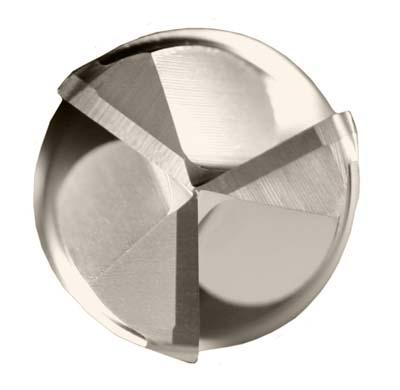
Helical Solutions is introducing the H40ALV and H40ALV-RN, representing a major expansion of its aluminum endmill series. The new endmills are robust additions to the Helical lineup and include intricate geometry additions for nonferrous machining solution. This new H40ALV line includes a variable-pitch flute configuration and cutting-diameter tolerances that are among the tightest in the industry (-.0001" to -.0004"). This precision delivers reduced chatter, fewer tool offset adjustments and optimum tool performance. Customers testing H40ALV prototypes report improved finishes and quieter operation. Previously offered as a premium customization, the line now includes a full corner radius option ranging from 0.015" to 0.250" as standard product. The corner radii allows customers to accommodate finish part requirements, offers improved part finish and superior corner protection. Additionally, tool life expectancy for the H40ALV line should show a significant increase. Also contributing to improved finishes are the H40ALV's wiper flats. Helical's wiper design burnishes the part floor without creating too much tool pressure/friction. Responding to customer requests for a more "opened up end geometry" due to the industry trend toward ramping and plunging in aluminum, the new H40ALV line includes new end geometry. The updated line of endmills is crafted of certified premium sub-micron grain carbide and available in stub, regular and reduced-neck lengths. A ZrN (Zirconium Nitride) coating that provides improved lubricity for maximum chip evacuation and resistance to abrasion for extended tool life is standard. The H40ALV-RN is similar in design and function to the H40ALV. The difference is that this tool has a reduced neck diameter with a relatively short flute length, allowing for longer reach into deep pockets while maintaining maximum tool rigidity, particularly useful for high-speed milling in pockets. Both the H40ALV and the H40ALV-RN are available in shank diameters ranging from ¼" to 1". Special configurations can be manufactured within 10 days. Helical recommends using high-pressure coolant, flood, mist or MQL when machining with these tools.
Related Glossary Terms
- chatter
chatter
Condition of vibration involving the machine, workpiece and cutting tool. Once this condition arises, it is often self-sustaining until the problem is corrected. Chatter can be identified when lines or grooves appear at regular intervals in the workpiece. These lines or grooves are caused by the teeth of the cutter as they vibrate in and out of the workpiece and their spacing depends on the frequency of vibration.
- coolant
coolant
Fluid that reduces temperature buildup at the tool/workpiece interface during machining. Normally takes the form of a liquid such as soluble or chemical mixtures (semisynthetic, synthetic) but can be pressurized air or other gas. Because of water’s ability to absorb great quantities of heat, it is widely used as a coolant and vehicle for various cutting compounds, with the water-to-compound ratio varying with the machining task. See cutting fluid; semisynthetic cutting fluid; soluble-oil cutting fluid; synthetic cutting fluid.
- endmill
endmill
Milling cutter held by its shank that cuts on its periphery and, if so configured, on its free end. Takes a variety of shapes (single- and double-end, roughing, ballnose and cup-end) and sizes (stub, medium, long and extra-long). Also comes with differing numbers of flutes.
- gang cutting ( milling)
gang cutting ( milling)
Machining with several cutters mounted on a single arbor, generally for simultaneous cutting.
- lubricity
lubricity
Measure of the relative efficiency with which a cutting fluid or lubricant reduces friction between surfaces.
- milling
milling
Machining operation in which metal or other material is removed by applying power to a rotating cutter. In vertical milling, the cutting tool is mounted vertically on the spindle. In horizontal milling, the cutting tool is mounted horizontally, either directly on the spindle or on an arbor. Horizontal milling is further broken down into conventional milling, where the cutter rotates opposite the direction of feed, or “up” into the workpiece; and climb milling, where the cutter rotates in the direction of feed, or “down” into the workpiece. Milling operations include plane or surface milling, endmilling, facemilling, angle milling, form milling and profiling.
- shank
shank
Main body of a tool; the portion of a drill or similar end-held tool that fits into a collet, chuck or similar mounting device.
- wiper
wiper
Metal-removing edge on the face of a cutter that travels in a plane perpendicular to the axis. It is the edge that sweeps the machined surface. The flat should be as wide as the feed per revolution of the cutter. This allows any given insert to wipe the entire workpiece surface and impart a fine surface finish at a high feed rate.
